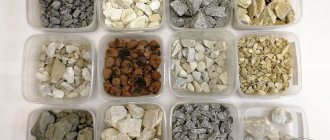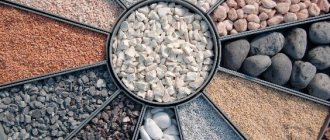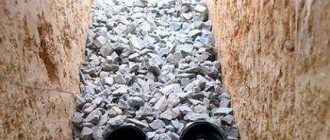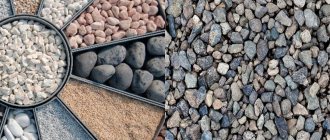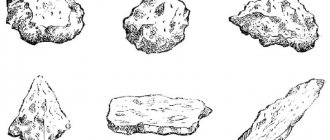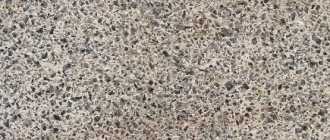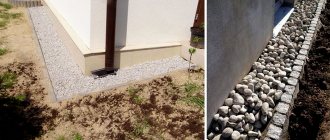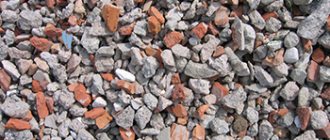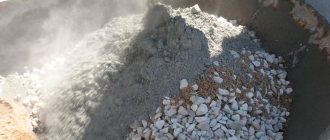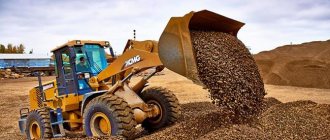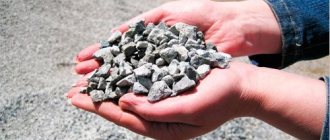Preparation and properties of limestone crushed stone
The raw material for this type of crushed stone is sedimentary rock limestone. Deposits of this mineral are located in territories covered in ancient times by seas and oceans. Limestone is the remains of the skeletons of ancient marine inhabitants accumulated and compressed over many millennia.
During the production process, limestone blocks removed from the ground are processed using crushing machines, resulting in the formation of crushed stone. Subsequently, it is sifted through special industrial sieves, divided into fractions depending on the size of the grains. After this, crushed limestone is delivered to trading enterprises for sale or to facilities for direct use.
The list of general properties of the material includes the following:
- fragility;
- low weight;
- frost resistance;
- environmental friendliness;
- grain color.
The most valuable quality from a decorative point of view is pure white color. This is explained by the fact that crushed limestone consists mainly of calcium compounds. The advantage of this crushed stone is its color stability - the grains remain white, despite environmental influences. Thanks to this, paths and flower beds decorated with limestone will always look beautiful and well-groomed. In addition, white stones are like a blank sheet of paper. They can be colored at any time, giving them any color to your liking.
Types of crushed stone
Granite crushed stone
Granite crushed stone
is crushed stone made from solid rock with a granular structure, which is the most common on Earth.
Granite rock is magma frozen at great depths. Consisting of well-formed crystals of feldspar, quartz, mica, etc. And has a color of red, pink or gray, depending on the predominance of spar and mica in it. Blocks are usually obtained by exploding a monolithic rock, then they are crushed in a machine, and the resulting crushed stone is sifted into fractions. This is the last stage of crushed stone production. Granite crushed stone fractions
- 0-5 mm (granite screening-ShchPS) is the smallest fraction of granite crushed stone, in the strict sense it does not belong to crushed stone, but is a by-product during its production. It is used as a decorative material for finishing, as well as for filling paths and roads, children's and sports grounds; for the manufacture of concrete products, in particular with the surface of “washed concrete”;
- 0—10 mm (ShchPS)
- 5-10 mm is the finest fraction commercially available. Used in the production of concrete and structures made from it to optimize the fractional composition of coarse aggregate, for example in the production of floor slabs using a formless method;
- 5-20 mm (a mixture of fractions 5-10 and 10-20) - is in greatest demand. Used in the production of concrete and structures made from it, in foundation work, when pouring bridge structures, bridge decks, road and airfield surfaces;
- 20-40 mm - average fraction. It is used in the production of concrete, reinforced concrete structures, in the construction of roads and railways, tram lines, in laying foundations and erecting industrial buildings;
- 25-60 mm - fraction used in the construction of foundations for railway tracks;
- 20-70 mm, 40-70 mm - coarse fraction, used in the production of concrete, massive structures made from it and for work with large volumes of concrete. It is also used in road construction within populated areas, during the construction of industrial buildings and structures;
- 70-120 mm, 120-150 mm, 150-300 mm (RUB) - rubble stone, used for backfilling, in gabions, for decorative purposes, usually for finishing fences, reservoirs, pools.
These are the standard, most common ways to use these fractions of granite crushed stone, however, for each of them there are many application options.
According to technical characteristics, granite crushed stone is durable (grade 800-1200) and high-strength (grade 1400-1600), frost-resistant (grade 300-400), with low flakiness (5-23%) and class 1 specific effective activity Aef (less than 370 Bq /kg).
The good properties of granite make it a popular building material. This is the best aggregate for high-quality concrete. Granite is also used as a decorative stone. It can be gray, red or pink and has many shades, after sanding and polishing it has a beautiful mirror surface. Granite mainly consists of feldspar, quartz, and mica crystals, the content of which affects the color and shades of the stone.
crushed gravel
Crushed gravel
- crushed stone obtained by crushing gravel into various fractions - 3-10 mm, 5-20 mm, 5-40 mm, 20-40 mm. Crushed gravel is used for foundation work, for concrete, in the production of reinforced concrete products, and in road construction. Crushed gravel is gravel that has been crushed by crushing or any other mechanical method and has 2 or more chipped sides of the stone.
Limestone crushed stone
A product of crushing limestone, consisting mainly of calcite (calcium carbonate - CaCO3).
Limestone crushed stone (sometimes also called limestone or dolomite crushed stone) is one of the main types of crushed stone, which, in addition to gravel and granite crushed stone, is used in road construction, as well as in the manufacture of reinforced concrete products. It is also allowed to be used in drainage installations, provided that it has a sufficiently dense structure.
Recycled crushed stone
Crushed stone obtained by crushing construction waste - concrete, brick, asphalt. To obtain it, the same equipment is used as in the production of other types of crushed stone, the process consists of the following main stages: first, construction waste is placed into the feeder hopper using a loader, then the crusher breaks large pieces into crushed stone, after which metal inclusions are sampled ( for scrap metal) and further fractionation of crushed stone on a screen (the unsorted fraction is also in demand).
The main advantage of recycled crushed stone is its low cost; on average, it is two times cheaper than granite. Energy consumption for its production compared to other types of crushed stone can be up to 8 times less. The cost of concrete using recycled crushed stone as a coarse aggregate is reduced by a quarter.
Recycled crushed stone has a wide range of applications:
- as a coarse aggregate for concrete with a strength of 5-20 MPa;
- in the road sector (filling roads, ramps, using roads that do not have federal status as the bottom layer);
- in landscaping works (pouring under asphalt areas, sidewalks);
- for strengthening weak soils (trenches of utility networks, bottoms of pits).
Slag crushed stone
Slag crushed stone is obtained by crushing waste metallurgical slag or special processing of fiery liquid slag melts (cast slag crushed stone). Currently, various types of concrete have been developed and used in construction using both binders and fillers based on metallurgical slag. The cost of products made from slag concrete is 20-30% less than traditional ones. Depending on the grain size, crushed stone is divided into fractions: 5-10, 10-20, 20-40, 40-70, 70-120 mm. The grain composition of slag crushed stone, like other types of filler, is selected to ensure minimal voids. The minimum bulk density of crushed stone of each fraction is 1000 kg/m3. The content of lamellar (flaky) and needle-shaped grains should be for crushed stone: cuboid - no more than 15%; improved - 25%; regular - 35%. The length of such grains is three or more times greater than their thickness or width.
Along with dense waste slag, porous slag is used for the production of crushed stone, formed from melts with high gas saturation, swelling with bubbles of released gases. Slag crushed stone is used not only as a filler for cement concrete, but also in road construction to strengthen foundations and construct asphalt concrete pavements.
Crushed stone grade by strength
The strength of slag crushed stone is characterized by its grade. For crushed stone from blast furnace slag used as a filler for heavy concrete, five strength grades have been established:
Crushed stone grade M1200 can be used in the production of concrete grade M400 and above, M1000 - grade M300, M800 - grade M200 and M600 - below grade M200. Low-grade crushed stone is also used in the production of concrete of higher strength, but after appropriate testing and a feasibility study.
Which fractions are suitable for decoration
The decorative function is best performed by the middle fraction with a grain size of 20 to 40 millimeters. The surface made from such crushed stone is smooth, which makes it both visually attractive and safe. Due to their high flakiness, the pebbles fit tightly to each other and form a smooth layer. You can walk on it in light shoes, or even barefoot, without harm to the soles and feet.
Large crushed stone, the grain size of which is 40-70 millimeters, is also suitable for decorating a personal plot. It is advisable to make decorative embankments and fills from this material for zoning the territory. One of the properties of limestone is resistance to temperature changes. Therefore, the shape of the crushed stone embankment will remain unchanged during repeated changes of seasons.
Large volumes of crushed stone are transported over long distances by open railway platforms. Heavy-duty dump trucks are also used for transportation. Particularly valuable types of material are transported packaged in thick paper bags.
The main area of application of crushed stone screening
Many people think that the use of dropouts is most common in landscape design, but they are wrong. A large consumption of screenings occurs in asphalt laying. Screenings are an important material in the production of high-quality concrete for asphalt, as it provides it with high strength. Here the screening serves as sand.
Screening is widely used in landscape design. There are many paths and areas on the street, which are lined with screenings. It mainly has the appearance of pink granite. Designers have come up with many ways to use this material in their field.
In addition to design, screenings are often used in the production of mortars. To obtain these solutions, sand is mixed together with screenings. Thus, significantly increasing the strength of the product. For example, sidewalks and curbs are laid from this mixture.
And last on the list are utilities. They use screening as a means of ice control.
If we talk about individual construction, screening is also used here. For example, in casting a foundation or designing a landscape design. This is not the entire liver where screening can be applied.
It may come as a surprise to many, but screenings are actively used for fertilizer in agriculture.
Crushed stone fraction for concrete
Crushed stone plays an important role in the concrete mixture. It is a large filler and provides high technical characteristics of the foundation. In the presence of crushed stone, concrete does not crack and can withstand loads for a long time. The filler prevents the process of shrinkage of the cement mortar and reduces its creep.
The crushed stone fraction for concrete is selected based on the purpose and features of the future structure. When constructing a large house, granite stones measuring 5-20 mm are used. If you plan to build a small facility, crushed gravel is preferred. This non-metallic material is quite durable. Therefore, it can withstand daily stress.
When solving any problem, from filling a sports field to constructing a hydraulic structure, the size of the crushed stone is important. The performance qualities of the foundation, reinforced concrete products and structures depend on how correctly the choice is made. Therefore, the purchase of non-metallic materials must be carried out with skill.
Crushed gravel fractions
In construction, the material obtained by sifting quarry rock is indispensable. Crushed gravel is only slightly inferior to granite stones. Therefore, it finds wide application. One of the main advantages of gravel is its lower cost. For little money you can purchase a large amount of non-metallic materials for pouring the foundation and producing reinforced concrete products.
Fractions of crushed gravel are different. We list the common options:
- 3-10 mm – small pebbles, the bulk density of which is 1.48 t/m3. This is a durable and frost-resistant material, in demand by construction and landscape companies. It is ideal for filling sidewalks and paths in city parks. The pebbles are pleasant to the touch, so it is good to walk on them barefoot. This point is taken into account by the owners of private beaches. They use gravel to fill the area;
- 5-20 mm - not a single construction site is complete without materials of inorganic origin. This fraction of crushed stone is in great demand. Non-metallic materials have low flakiness (about 7%), bulk density of 1.37 t/m3 and excellent frost resistance. Small stones are used in the manufacture of reinforced concrete products. This crushed stone fraction is also suitable for concrete. Therefore, bulk materials are often used in construction;
- 20-40 mm are medium-sized stones with a high level of strength. Their bulk density is 1.39 t/m3. Flakiness – 7%. The range of applications for the crushed gravel fraction 20-40 mm is wide. It is used when arranging “cushions” of highways, when pouring foundations, and when creating railway tracks. Crushed gravel has a low radioactive background. Therefore, it is considered an environmentally friendly material;
- 40-70 mm - a large fraction of crushed stone extracted from quarry rock. It is optimal for creating a strong and reliable foundation. Concrete floors are made from crushed stone of this size, embankments are made on railways and drainage systems are developed. Bulk density of non-metallic material is 1.37 t/m3. The stones compact well and are not afraid of the negative effects of low temperatures.
Crushed stone fractions GOST 8267-93 is an international standard applicable to materials extracted from rocks. It provides technical requirements, definitions and normative references. Manufacturers adhere to the established standard and supply materials that comply with the standards.
How to make a solution from screenings?
To create a high-quality solution from screenings, cement and water must be of high quality so that the finished material is durable. It also depends on the correct proportions.
It is best to search the Internet for “how many dropouts do you need” so as not to make a mistake. List of necessary materials and tools for making the solution:
- cement;
- dropout;
- water;
- mixing tool (concrete mixer).
Sand is a popular building material, and this makes it quite expensive. Thanks to modern technologies, it has become possible to replace sand with conventional screening.
The quality characteristics will not deteriorate from this. That is why today many manufacturers prefer crushed stone screening and actively use it for various purposes.
